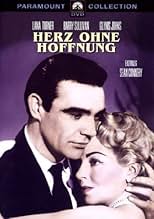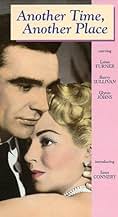IMDb-BEWERTUNG
5,8/10
944
IHRE BEWERTUNG
Ein amerikanischer Kriegskorrespondent verliebt sich in eine BBC-Reporterin, aber ihre Beziehung scheint von Anfang an dem Untergang geweiht.Ein amerikanischer Kriegskorrespondent verliebt sich in eine BBC-Reporterin, aber ihre Beziehung scheint von Anfang an dem Untergang geweiht.Ein amerikanischer Kriegskorrespondent verliebt sich in eine BBC-Reporterin, aber ihre Beziehung scheint von Anfang an dem Untergang geweiht.
- Regie
- Drehbuch
- Hauptbesetzung
Jack Armstrong
- Reporter
- (Nicht genannt)
Mabel Etherington
- Woman at Inn
- (Nicht genannt)
Lee Fenton
- Reporter
- (Nicht genannt)
Aidan Harrington
- Man at Inn
- (Nicht genannt)
Empfohlene Bewertungen
I had heard a lot about this film. I like Lana Turner and I have always thought that Glynis Johns is one of the loveliest British actresses who ever went to Hollywood - our loss, their gain. She seemed to steal every scene that she was in.
I thought this was just going to be another love story with a wartime background, but it was more than that. It turned out to be a very touching and human story.
The scenes of Cornwall were beautiful. It would have been great in colour, and the film had the loveliest ending that I have ever seen in any film of this genre.
Lana Turner never won an Oscar, but I am surprised that she was not, at least, nominated for an Academy Award for this picture. She was always good at playing this sort of role, lighting up the screen as her performance developed.
I am not usually a fan of love stories, but there was just something about this film that made me keep watching it. I do not know what it was. Maybe it was just Lana Turner's performance and the beautiful scenes of Cornwall. I have recorded it on Talking Pictures. I might even watch it again.
I have also enjoyed watching Sean Connery in one of his early roles. He is always good, no matter what film he is in. However, I should imagine that British audiences must have sat in the cinema wondering how a Scotsman could have been born in Cornwall.
I thought this was just going to be another love story with a wartime background, but it was more than that. It turned out to be a very touching and human story.
The scenes of Cornwall were beautiful. It would have been great in colour, and the film had the loveliest ending that I have ever seen in any film of this genre.
Lana Turner never won an Oscar, but I am surprised that she was not, at least, nominated for an Academy Award for this picture. She was always good at playing this sort of role, lighting up the screen as her performance developed.
I am not usually a fan of love stories, but there was just something about this film that made me keep watching it. I do not know what it was. Maybe it was just Lana Turner's performance and the beautiful scenes of Cornwall. I have recorded it on Talking Pictures. I might even watch it again.
I have also enjoyed watching Sean Connery in one of his early roles. He is always good, no matter what film he is in. However, I should imagine that British audiences must have sat in the cinema wondering how a Scotsman could have been born in Cornwall.
Another Time, Another Place is a multi-dimensional movie. Keeping in mind that it is fifty-eight years old, I imagine the storyline and character building was fairly innovative. Still today, the acting, script, and directing were relevant enough on a general level and pulled me in. I felt drawn towards each character and their individual plights, albeit some more than others. Emotions emanated off the screen, and some scenes were very powerful. While this isn't the best movie of all time, and arguably may not be the peak of Turner's and Connery's careers, it is certainly a heartfelt film that deserves respect.
Sean Connery and Lana Turner are journalists who fall in love, in this enjoyable war time melodrama. Connery plays Mark Trevors, a radio reporter for the BBC and Turner plays Sara Scott, posted in London working for an American newspaper. Their relationship, which is never fully developed, has a sting in the tail. The second half of the story takes place in Cornwall, and although filmed in black and white, the scenery is still alluring. Turner, who gets most of the screen time, gives a decent performance and Connery, who at the time was relatively unknown, demonstrates the charisma which makes him a potent screen presence.
Whilst on assignment in a very 1950s-looking WW2 London, a plastic-haired US ace-journo' (Turner) and an impossibly baby-faced Cornish ace-journo' (Connery) are lost in the throws of a torrid affair, despite the disapproval of colleagues (stiff-upper-lip Longdon, laconic James). However, even as declarations of undying love are uttered, dark clouds loom in the form of Turner's newspaper boss and erstwhile lover Sullivan, and Connery's shock disclosure that he has a wife and child tucked away in his native Cornish village. When Connery is killed in a plane crash, a devastated Turner makes a pilgrimage to his native Cornwall where her path crosses that of his wife and child...
Risible weepy, serving as a star vehicle for Lana and an early showcase for the handsome young Connery, both of whom fail miserably to convince. Turner seems to possess only three facial expressions, even when trying to stay upright in her stilettos as she totters round 'St. Giles' (actually Polperro) - witness her horribly 2-D efforts to comfort Martin Stephens after his nightmare. Meanwhile Connery's description of his Cornish fishing village birthplace is delivered in such a rich Edinburgh brogue as to be quite giggle-some.
So often the case with British cinema of the 40s and 50s, it's the support players who steal the show - Glynis Johns' is a beautifully judged and modulated depiction of a woman recovering from grief. Her resolute kindness, generosity and warmth make her reaction to the final reel revelations all the more believable. Sid James shines as a world-weary American journalist trying to juggle loyalties, and Stephens' post-nightmare scene is desperately convincing.
Sadly however, excellent support playing, and beautiful location shooting are just not enough to save this overwrought turkey.
Risible weepy, serving as a star vehicle for Lana and an early showcase for the handsome young Connery, both of whom fail miserably to convince. Turner seems to possess only three facial expressions, even when trying to stay upright in her stilettos as she totters round 'St. Giles' (actually Polperro) - witness her horribly 2-D efforts to comfort Martin Stephens after his nightmare. Meanwhile Connery's description of his Cornish fishing village birthplace is delivered in such a rich Edinburgh brogue as to be quite giggle-some.
So often the case with British cinema of the 40s and 50s, it's the support players who steal the show - Glynis Johns' is a beautifully judged and modulated depiction of a woman recovering from grief. Her resolute kindness, generosity and warmth make her reaction to the final reel revelations all the more believable. Sid James shines as a world-weary American journalist trying to juggle loyalties, and Stephens' post-nightmare scene is desperately convincing.
Sadly however, excellent support playing, and beautiful location shooting are just not enough to save this overwrought turkey.
Set in Cornwall (not that you'd know from the accents, least of all Connery's) in 1945 (not that you'd know from Lana Turner's chic fifties wardrobe). The title is apt, as it belongs to a very specific moment in 1957 when Sid James was still playing Americans, Lana's film career was simply treading water (just before the publicity resulting from the Stompanato scandal revived it again) and Sean Connery - suffering yet another false start - cost next to nothing. Likewise it completely lacks the glossy high contrast colour photography by Russell Metty and mellow piano music by Frank Skinner (rather than the noisy score here by Douglas Gamley) that became a hallmark of her vehicles for Ross Hunter.
Turner's penchant for Bad Boys showed both in her offscreen liason with Johnny Stompanato and her onscreen one with a Connery still sporting his original bushy eyebrows. But it's really about Lana's relationship with Connery's wife Glynis Johns.
Turner's penchant for Bad Boys showed both in her offscreen liason with Johnny Stompanato and her onscreen one with a Connery still sporting his original bushy eyebrows. But it's really about Lana's relationship with Connery's wife Glynis Johns.
Wusstest du schon
- WissenswertesDuring the shooting of the movie in England, Sir Sean Connery was confronted by Johnny Stompanato, an ex-marine turned mob enforcer, who was in an abusive relationship with Lana Turner. At the time, Connery and Turner got along very well, so much that when Stompanato found out about it, he suspected that they were having an affair. Stompanato, who was notorious for his jealousy and violent tendencies, then stormed to the set and threatened Connery with a gun. But he quickly disarmed Stompanato and forced him from the set. Following that incident, Stompanato was deported by Scotland Yard. Shortly after he arrived in the USA, he met his end at the hands of Turner's teenage daughter Cheryl, who fatally stabbed him in self-defence while he was beating her mother. Connery, who was filming Das Geheimnis der verwunschenen Höhle (1959) at the time of the latter incident, behaved very cautiously when he walked the streets of Los Angeles, because it was rumoured that a mobster made him responsible for Stompanatos death. That caused him to avoid the USA for several years.
- PatzerThe story takes place in 1945, but all the women's hairstyles and clothes, particularly the high fashion designs worn by Lana Turner, are strictly 1958.
- Zitate
Kay Trevor: Music has such a way of bringing back memories doesn't it? Does it remind you of anyone?
- VerbindungenReferenced in Feuerball (1965)
- SoundtracksAnother Time, Another Place
Written by Jay Livingston and Ray Evans
Top-Auswahl
Melde dich zum Bewerten an und greife auf die Watchlist für personalisierte Empfehlungen zu.
- How long is Another Time, Another Place?Powered by Alexa
Details
- Laufzeit1 Stunde 31 Minuten
- Farbe
- Seitenverhältnis
- 1.85 : 1
Zu dieser Seite beitragen
Bearbeitung vorschlagen oder fehlenden Inhalt hinzufügen

Oberste Lücke
By what name was Herz ohne Hoffnung (1958) officially released in India in English?
Antwort






























